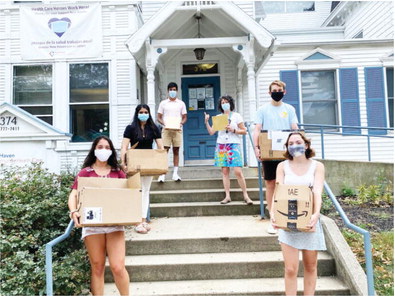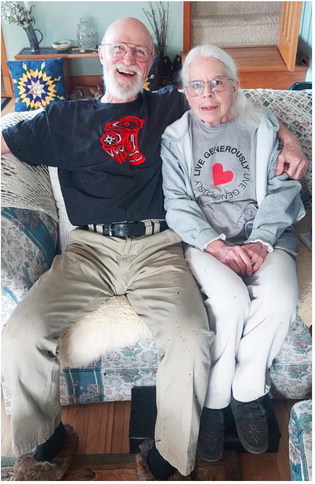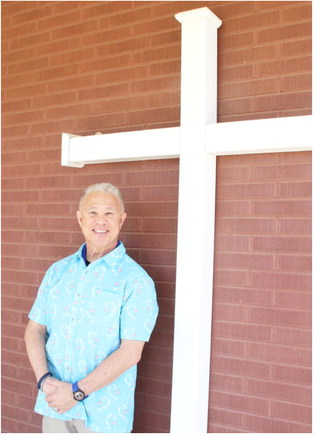Telemedicine And Montana’s Digital Divide


How One National Nonprofit Is Equipping Seniors For The Future Of Health Care
Montana Free Press
When COVID-19 safety protocols shifted whole sectors of the health care industry from in-person visits to a telehealth model, Arjun and Hannah Verma watched their parents — a pulmonologist and a cardiologist — fret about some of their elderly patients who were unprepared for the switch. The elder Vermas were concerned that their patients who didn’t own camera-enabled devices or know how to use videoconferencing platforms would be forced to forgo critical care.
Arjun and Hannah, who live in Orlando, Fla,, realized they had a few devices around the house they weren’t using, and they figured some of their friends and family members might, too. They started soliciting smartphone and tablet donations, and the response was so heartening and immediate that they decided to set up a nonprofit to provide senior patients — and later, low-income patients as well — with free devices and the technical guidance to use them.
Since launching in March, Telehealth Access for Seniors has raised $85,000 and donated 1,900 devices — some brand-new — to seniors and low-income people in 26 states. Alongside cofounder Aakshi Agarwal, Hannah’s classmate at Yale, Arjun and Hannah have coordinated the efforts of 315 volunteers, mostly students.
Although Montana is not currently among the 26 states Telehealth Access for Seniors serves, it would be hard to argue there isn't a need for such a service. According to median age statistics from the U.S. Census Bureau, Montana is the oldest state west of the Mississippi, and the Pew Research Center has found that about six in 10 American seniors don’t own smartphones.
As with many things coronavirus- related, Telehealth Access for Seniors’ footprint in this state is subject to change. Siddharth Jain, who joined the nonprofit as its treasurer, said health care providers and volunteers who are interested in collaborating should get in touch.
The organization’s model centers on its volunteers, who round up devices and financial donations from their networks. After sanitizing, resetting and charging donated devices, volunteers stuff tech guides and chargers into packages that they deliver to local health care providers. The providers are often able to set up the devices with their patients on the spot, Jain said, but if the patient runs into an issue, instructional videos and PDFs are available in multiple languages on the Telehealth Access for Seniors website. Those who require further assistance can call a 1-800 number to troubleshoot hiccups with technology-savvy volunteers 24 hours a day — again, in multiple languages.
Though the initial focus on the group’s effort was to expand access to health care, Jain said the digital connectivity aspect has also been helpful in fighting social isolation, a condition that can contribute to serious medical conditions. Social isolation is all too common among elderly adults in this country, even pre-COVID.
The devices belong to the patients indefinitely, Jain said, and can be used for any number of things, including digital grocery shopping, Zooming and FaceTiming with family. Telemedicine: COVID’s ‘Silver Lining’ The widespread adoption of telehealth across the U.S. — and how public policy has made way for it — is perhaps the most dramatic shift the pandemic has pressed on the health care industry.
Montana Primary Care Association CEO Cindy Stergar said the community health centers her association represents have been using telehealth for a couple of years, but “once COVID happened, it really skyrocketed.”
“Medicare had some really stiff rules around reimbursement that they opened up,” she said. “[Once the pandemic hit], it became much easier for patients and providers who want to do telehealth.”
It’s a development that her organization has welcomed and would like to see continue, especially given how rural Montana is. She said telehealth programs can be particularly helpful for residents of areas like Beaverhead County, where cattle far outnumber humans on a landscape that’s larger than Connecticut. Ranchers in this part of southwestern Montana can easily eat up the better part of a day accessing even relatively straightforward care, she said.
“Every time a doctor says something like, ‘Come back, we’ll just do a recheck in three weeks,’ and they have to drive three hours, they think, ‘You’ve got to be out of your mind. Why can’t I just call you?’” Stergar said.
Telehealth isn’t appropriate for all forms of health care, and there will always be patients — and providers — who prefer in-person visits, but Stergar said it should be a part of the mix going forward.
“If there’s a silver lining [to COVID-19] in health care, it’s that it made everybody go to telehealth,” she said. “Everyone knows how to do it now.”
Bridging The ‘Digital Divide’ Even with patients and providers outfitted for and willing to use telemedicine, there’s still the matter of connecting to the internet. And that, Stergar says, is a sizable barrier.
Montana ranks 50th in the nation for broadband access, according to Broadband-Now, which compiles information on internet service providers for consumers. Only Alaska ranks lower. According to BroadbandNow’s data, 203,0000 Montanans — about one in five — don’t have access to 25 mbps download speeds, the broadband standard the Federal Communications Commission adopted in 2015 to reflect changes in consumers’ internet use. (At speeds of 25 mbps, most consumers can comfortably stream video or use video- conferencing platforms.) Cost also contributes to the digital divide in Montana. Less than 1 percent of the state’s residents have access to a wired broadband plan for $60 or less. For comparison, 62 percent of Idahoans and 20 percent of Wyomingites have access to affordable broadband.
Stergar said the Montana Primary Care Association has been advocating for nationwide high-speed internet to be included in federal infrastructure spending. She’s raised the issue with U.S. Senators Jon Tester and Steve Daines, who both started pushing for rural broadband expansion long before COVID-19 threw the gap between the digital haves and have-nots into such sharp relief.
“Without access to broadband and cell service our rural communities are being left behind,” Daines said nearly two years ago in a press release about an FCC rule change allowing Montana wireless providers to purchase the specific electromagnetic radio frequencies that providers use to transmit data. “Access to reliable broadband and cell service is vital for Montana’s future economic growth.”
Tester said COVID-19 highlights just how critical rural broadband development is. “If there’s one thing this pan- 

